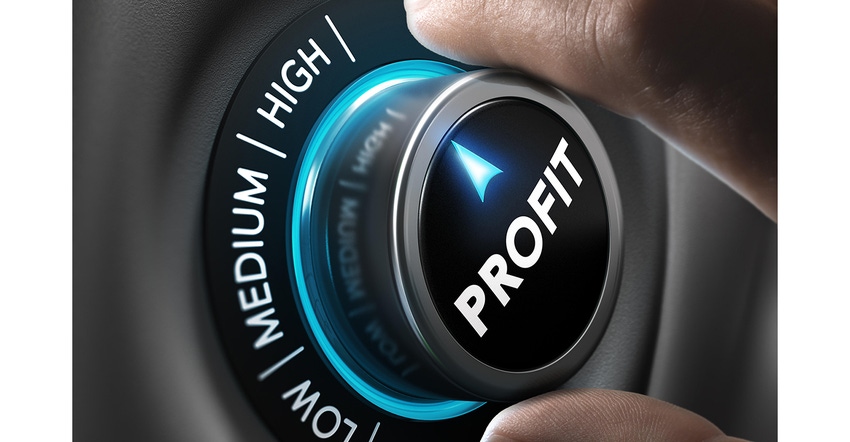A sensible costing strategy provides plastics processors with a solid financial foundation to protect their business against profit drains.
March 25, 2022

Plastics processors are fortunate to have several options for managing and calculating costs. While each has its own set of advantages, all provide a slightly different path to the bottom line. Determining which costing strategy best fits your situation requires a basic understanding of each.
In part one of this series we discussed the benefits of a production profit contribution model. Part two detailed the simplified standard costing method. A third costing approach, managing profitability and cash flow, is presented here, the final installment of this series. This article will focus on the critical controls required to manage profitability and cash flow in your daily, weekly, and monthly life. Similarly, we will discuss the roles and responsibilities within the organization and the sequence of the processes.
You may be experiencing high levels of profitability and cash generation at this time. If that’s the case, continue with what’s working. But there’s almost always room for improvement. So, if you need “automatic-pilot” controls in your absence, then consider implementing a managing profitability and cash flow approach to costing.
Where are the tenets?
There are strategic and critical areas in plastics processing where efficient controls can be implemented:
The sales order approval stage;
the production preparation and planning stage;
immediately following production;
tracking weekly contributions and cash flows;
annual customer price list profitability review.
It is essential for these stages to be correctly staffed and your company data be made available to these people so that responsibilities can be fulfilled independently. Staffing could require anywhere from two to four resources. Depending on the volume of transactions, these may be full- or part-time positions.
For sales approval and to track the weekly contribution, some cost accounting knowledge is useful. For the production side, a management-level resource (or together with an assistant) should have an understanding in terms of production speed efficiency, raw material efficiency, and production yield (i.e., reject count). Again, these calculations can be learned, and the manager can get help compiling them for each work order. One note here: It’s vital to collect data on the production floor immediately following production.
Finally, it is important to conduct price list reviews to ensure that expected sales volumes are met. Reviews should examine the overall profitability of a customer, including the actual production efficiency of all products manufactured for that customer. This is done typically on a yearly basis. Obviously, the process can be greatly accelerated, and administrative costs can be reduced by using software designed to automate the collection and sharing of production data along with cost information.
The sales order approval gate
Successful companies continually check costs for accuracy based on actual production results and raw material price fluctuation. To maintain proper profitability, adjustments are then made to the sales price, internal production methods, or tooling. For example, volatile oil prices can cause resin prices to fluctuate, affecting product costs. Checking costs prior to approving a new sales order provides an opportunity to recheck costs and consider previous production efficiencies. It’s important to note that these adjustments can be made prior to approving the sales order, not after.
Many plastics processors review product standard costs on an annual basis. This is an outdated approach that may generate material financial statement variances. That said, I would not advocate reviewing product standard cost (or estimate) when a minimal discrepancy is encountered. In such instances, a new product cost should be put in place.
To improve financial statement accuracy, consider maintaining an average product standard cost, as this represents the most accurate way to cost finished product inventory. Work-in-progress product inventories should be costed at the current product standard cost.
It is suggested to take the following steps prior to a sales order approval:
Review all current raw material purchase prices (including duty and shipping costs) versus those in the current product standard cost (raw material variance).
Review the production yield (rejects) of previous production runs (product cost efficiency).
Review production time and down time versus the product standard cost (production speed efficiency).
Review the product order size, as smaller orders may not cover the production setup costs and require additional setup charges.
Calculate the new product standard cost versus the current one.
Submit the results to management if a material change has occurred.
If the review does not reveal material cost issues, the order may be dispatched. I’ve seen plastics processors who maintain a 5 to 10% product inventory for their best customers. This will help avoid additional setup charges and long delays for emergency situations. While there is always a risk that product specifications may change, this can be avoided by shipping any excess with each sales order and replacing it with a new reserve.
Finally, it is recommended that the person assigned to verification at the sales order approval stage should also calculate actual post-production costs. This individual is well positioned to review results of the new product standard cost prediction and make notes for the next order.
Before, during, and after production
Taking the proper amount of time to prepare the next production runs can reduce costs. Here are a few suggestions:
Review problems and solutions. Understand the root cause and implement corrective action for future runs.
Ask: "Was there a particular machine where we consistently obtained better production results and lower rejects?" This will help to plan the best environment for a better run.
Determine if the use of regrind raw material is an option. If so, check to see that it is available and verify the percentage that can be used without creating quality issues.
During production, it is important to capture basic data. This should include:
Usage of each raw material;
the number and length of setup times;
downtimes and reason(s) why;
reject quantities — the reason(s) and solution(s);
production speed and times of the run;
finished product quantities produced;
part weight (i.e., can be used to estimate raw material consumption).
While an automated data capture system is best, manual entries compiled after the production run also will work. PLCs can also be used to track the production speed and parts produced. Obtaining and compiling basic daily production data and efficiency for each work order will help guide production management on daily performances, such as:
Reject quantities and total production yield — overall product efficiency;
raw material efficiency (quantity used versus quantity at standard);
production speed efficiency, which affects labor and machine times;
down times — reason(s) for them as well as problem/solution reporting.
At this point, a daily production profit contribution can be calculated. This is determined by subtracting raw material cost (including rejects) from the product’s sales price. As a check, all products produced throughout the day should add up to a total daily production profit contribution. (This will be covered next.)
Once a production work order is completed, the actual product cost can be compiled and compared to the standard product cost. Again, it makes sense that the same person used at the order approval stage performs this calculation. This also serves to ensure that all production data have been properly compiled.
Controlling production cash flows
Plastics processors generate the bulk of their cash flow from production activities. Using the previous year’s financial results, and the forecasted income statement, look at the year’s total projected sales. Deducting raw material costs estimated for those sales will provide a total contribution required for that year. This number can be further broken down by month, weeks, days, and even shifts. For instance, predicted sales of $10 million with raw material costs of $6 million will require an annual contribution of $4 million. This translates into a monthly target of $333,333 and a weekly target of $76,923 to cover estimated annual fixed costs and profit margin.
The daily production profit contribution explained earlier now can be compared with this target. This will ensure that appropriate profit levels are generated when producing goods within a given timespan. Remember, a company may be very efficient in terms of production and quite profitable regarding its products; however, if the volume is low, cash flow may not be sufficient to ensure profitability. Meeting targets assumes that customers will eventually pay for products produced on a profitable production calendar basis. This is likely to happen when products are shipped.
It is recommended to have a weekly invoicing target. Taking the above example, one should have a weekly target of $192,308. Compare this number on a cumulative basis against what is invoiced each week. One can even extrapolate the direction of your total with the number of weeks remaining in the year. In this way, you will be confident in meeting forecasted sales. If not, you should recalculate the production profit contribution to ensure that annual fixed costs and profit margin are covered.
Controlling fixed costs
Given that production cash flows, such as raw materials, are controlled, all other costs become fixed cost. These expenses can be tracked monthly such as:
Payroll cost (direct and indirect, can be by department);
maintenance parts (best place to purchase);
marketing and advertising (media buys, trade shows, and others);
external professionals and services (auditor, IT services, legal, and others);
communications (phone, internet);
utilities (check consumption);
insurance (group, company and life insurance);
and so on…
It’s essential to control what’s important and not to allow such things to exceed your budget. Whenever possible, look for better solutions at a lower cost and invest in automating internal systems. This will save time while eliminating unnecessary operational and administrative costs.
Customer price list and terms review
Most integrated business systems allow users to keep a product price list for customers. This is a wise move for plastics processors due to the frequent price reviews that must take place as resin prices fluctuate. Further, it provides the flexibility to regroup products under one or many price lists. Reviewing this information will help companies manage the overall profitability of a customer.
Allow me to offer some advice on terms. Given the frequent volatility in the price of oil, plastics processors should always work out an agreement whereby sales prices are dependent on resin-price fluctuation. Terms can also include an allowable limit regarding acceptable over and under shipping. This is a common practice for the industry. Similarly, precautions can be taken against potentially bad debts by offering sales discounts as payment discounts to get your money quickly (10%/10 days, for example).
Consignment inventories are yet another way to protect yourself and provide better service by maintaining a constant inventory level. Typically, any unused inventory after a certain period (such as 60 days) is automatically invoiced to the customer.
Consider the following questions when reviewing a customer price list:
Is the customer purchasing the volume he or she committed to buy?
Given the production performance, can the same price be maintained?
Is there a change from year to year in the products purchased by the customer?
Can we improve the production yield and efficiency for any of the product sold?
Are we generating enough cash above direct costs (i.e., material, labor, commissions, shipping, payment discounts, and so forth)?
What is the actual profitability for all products of a given customer?
What is the production profit contribution of that customer; and does it meet our objective?
A customer might not meet your target profitability, but it might be that production improvements can be made to meet that goal. Also, during down time, it is better to recover fixed costs when you cannot produce at full capacity. When a customer is very profitable, you could have a “loss leader” product that does not generate cash above its direct cost. If that is not the case, discontinue producing that product unless a price change occurs.
Finally, small gradual price increases can eventually help you reach target profitability without the risk of losing the customer. Performing such an exercise each year can be a great way to connect with your customer and create a win-win situation.
Choosing what’s right for you
From excessive scrap rates and slow production to questionable product pricing, the over consumption of raw materials, underutilization of regrind material, and more, plastics processors face a number of daily obstacles. Applying a sound costing strategy provides a solid financial foundation while helping to protect the business against these and other profit drains.
Managing profitability and cash flow, production profit contribution, and simplified standard costing are all viable options for managing and calculating costs. Each approach has its merits, yet they are not mutually exclusive and may co-exist within an organization. The important thing is to understand the purpose, unique strengths, and disadvantages of each and determine which method is the best fit for your organization. Selecting and implementing the optimum costing approach will deliver a measurable and sustained improvement to the bottom line.
|
About the author
Pierre Maillet is founder of CyFrame International Enterprises Inc. A graduate of the University of Ottawa, Maillet is a CPA. Prior to CyFrame, he worked as a software applications specialist (Hewlett Packard) and IT management consultant (KPMG). Today, Maillet applies his experience and expertise to helping toolmakers and plastics processors improve production efficiency and profitability.
About the Author(s)
You May Also Like





